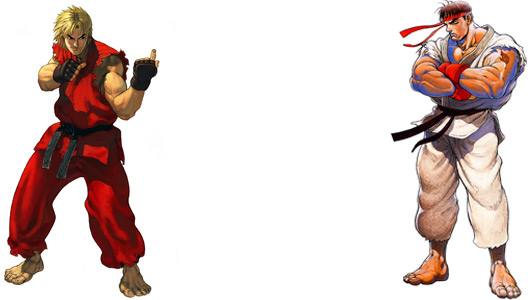
I said that one of the reasons Street Fighter II became an iconic game was because of how the characters were balanced. I'm not talking about how the fighting mechanics were balanced, but instead how each of the main characters had a sort of visual rival. It didn't matter if it was a friendly rival or an arch rival. Ken had Ryu, this was a literal balance, but Ryu also had Sagat, which was an asymmetrical balance. Having two main stars in the game created a trend that would be used by other studios. Ryo and Robert in the Art of Fighting, Akira and Jacky in Virtua Fighter, Haohmaru and Genjuro from Samurai Spirits were other examples of balanced main characters. There was something that the team at Capcom added to make the lineup more unique in the Street Fighter Zero / Alpha series. They weren't afraid to play with the roles and genders as well. Sakura was very much a girl version of Ryu. She had her own rival with Karen, who was like a girl version of Ken. These rules also applied to villains.
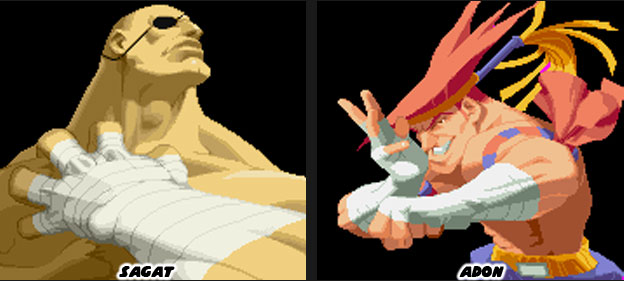
Having a younger rival was an excellent way to expand a character library. Sakura for example wanted to become a great fighter like the person she idolized. She trained very hard and even dressed a little bit like Ryu, with a similar headband. Then there were young rivals like Adon who wanted to dethrone their mentor. Ed was similar in this regard. People in Shadowlaw fought their way to the top. The four generals in the organization represented the most dangerous fighters in the universe. M. Bison the Boxer, Balrog the Claw Assassin and Sagat the Muay Thai champion were brutal opponents. Their boss Vega / the Dictator was absolutely ruthless. If Ed hoped to remain in their presence then he would have to surpass them. In his ending in Street Fighter V it is suggested that he might organize his own group to take over Shadowlaw. This wasn't the first time that a young character was created with the intent to replace and established fighter. In the early stages of Street Fighter III development the people at Capcom looked at only having Ken and Ryu return. They enjoyed the success of the World Warriors introduced in Street Fighter II. So they wanted to create a new cast with similar archetypes.
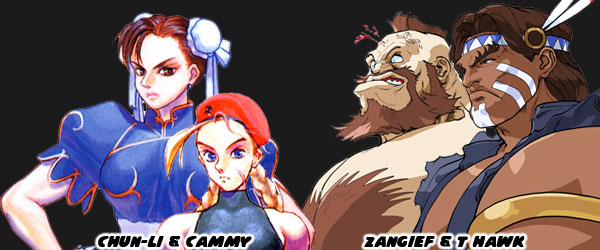
Two of the characters that were far along in the design process were Cammy and T. Hawk. They were going to be the updated version of Chun-Li and Zangief respectively. Plans for Street Fighter III were scrapped and these new figures were introduced in the upgrade called Super Street Fighter II: The New Challengers. The team at Capcom did a good job of recreating the archetypes without making these new characters look exactly the same as the veterans. Chun-Li was a special agent for Interpol. Her Chinese heritage was reflected in her costume. Cammy was a soldier working for Delta Red, her uniform looked more militaristic. Zangief was a powerful figure with some hard hitting slams. He was a Russian fighting for the pride of his homeland. T. Hawk was a native character, younger and bigger with equally powerful slams and protective of his reservation. By making the new fighters slightly younger it meant that they might be brought back in sequels, along with Ken and Ryu as older, more mature fighters. The thing about this school of design was that it worked almost as well when introducing older characters into the series.
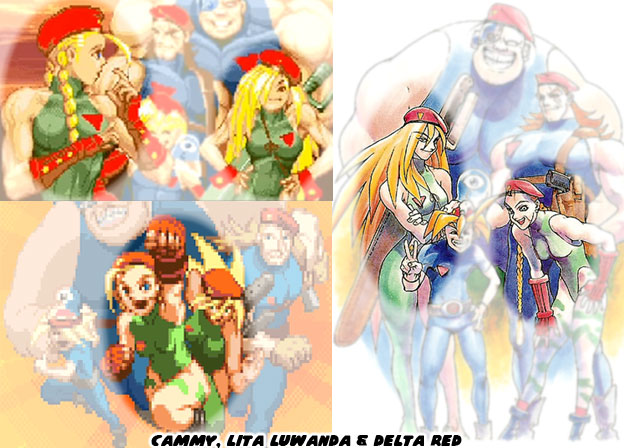
When planning out Cammy the studio wanted her team to be as unique. One of the members, Lita Luwanda, was a weapons expert. She also had long blonde hair, a green leotard and the trademark red beret. She could easily be mistaken for Cammy's older sister. The style of this character complimented the other fighters very well. She could have popped up instead of Cammy in a Street Fighter sequel and I think audiences would have enjoyed her and the massive sword she used. A designer could push the age of the character to the far end and still find a fit with the series. Gen and Oro were elderly fighters that worked well in their respective appearances in Street Fighter Zero and Street Fighter III. Gouken, the elder master of Ken and Ryu had been written about for years but had only appeared as recent as Street Fighter IV in 2008.
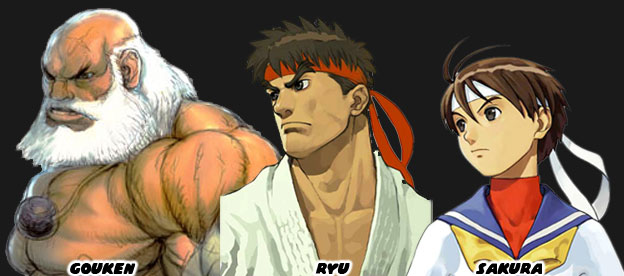
Gouken, Ryu and Sakura had a similar form of fighting but the differences between the three were very profound. If you are designing characters for a story, game or comic look carefully at how Capcom distinguished the trio. Gouken was at the peak of his abilities, every move that he had oozed power. He had techniques that were not yet known to Ryu or Sakura. He could perform the famous fireball attack with one hand, showing how much more advanced he was than the younger stars. Sakura was in the early stages of her abilities. She couldn't yet perform a proper hurricane kick so she would spin on her sneakers across the floor. Her fireball lacked the speed and range of the old master. Ryu was closer in terms of moves and abilities to Gouken than Sakura. Although the three had similar techniques, they all employed different strategies in the game. If you are thinking of designing your own fighters remember that characters can be from the same school but they should not all play the same. Gouken, Ryu and Sakura played as uniquely as they looked.
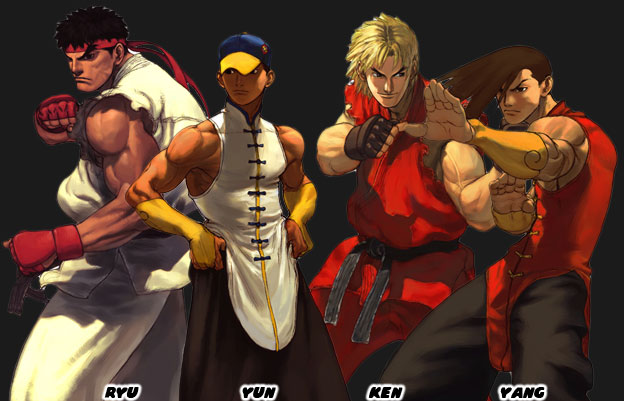
When development got started on an actual Street Fighter III Producer Tomoshi Sadamoto and Designers Yasuhiro Seto, Tomonori Ohmura and Obata Shinichiro were very mindful of the things that went into the creation of the original Street Fighter and Street Fighter II. They decided that only Ken and Ryu should return and there would be a new story and new main villain. The duo were joined by a new library of fighters and styles. Dubbed the "New Generation" these fighters were not necessarily based on previous characters but there were some similarities to them. The new heavyweight, Alex, was a hybrid fighter, with both strikes and grapples in his arsenal, similar to Adon and Birdie. Necro had stretchy limbs and electrical attacks, similar to Blanka and Dhalsim. Hugo was originally planned as the super-heavyweight, the Zangief of the game, but his sprites weren't ready until a few months after the game debuted. The two characters that were most similar were the brothers Yun and Yang. In design and temperament they were like a young Ken and Ryu. They even had a familiar red and white color scheme. If the developers made one mistake it was in having the moves of Yun and Yang be too similar, making them redundant. It took Capcom plenty of sequels to make the library of moves between Ken and Ryu unique. They forgot this while planning out Yun and Yang, and as such they didn’t take off as well as the studio had hoped.
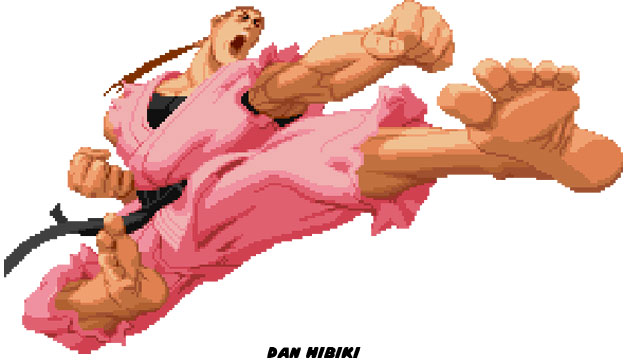
Capcom didn't always get the designs perfect the first time they were released but they quickly adapted. Well, at least they used to. For a long while every time they put a karate character in the game they played similarly to Ken and Ryu. Making fighters like Gouki, Sakura, Dan, Sean, Kairi, Allen Snider and Gouken were far more redundant than Yun & Yang. In fact this group of karate fighters were dubbed "Shotoclones" by the fighting game community. Yet the designers went back and challenged themselves to rethink the karate form. They incorporated the elements of an established character and then applied them to a younger fighter. Not only that, they considered changing the sex and ethnicity of the characters as well. They even gave these characters a unique form of karate. The final version of Street Fighter III, called 3rd Strike, Capcom expanded the library again. Of the new characters Makoto was a strong, young female, but she also had a new form of karate. She did not play like Ryu, and did not use the same strategies. Her attacks were amazing and they all worked well in the context of the series.
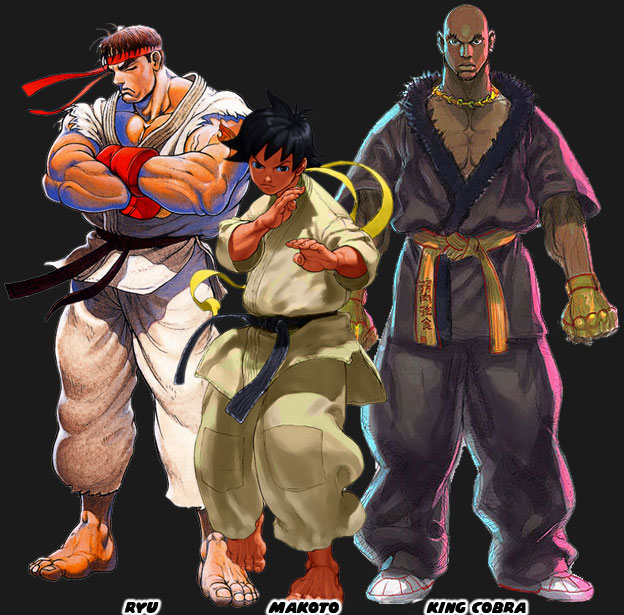
Capcom reminded us that no two styles, even from the same school, had to play the same. Makoto could never be considered another shotoclone. Even the unused design for the King / Black Cobra had a uniqe version of karate/kung-fu. These lessons had worked in previous games. No two giants had to play the same, like Zangief and T. Hawk. No two Muay Thai specialists had to fight the same, like Adon and Sagat. All of the archetypes were flexible. If you were a designer and couldn't think of where to take a character or style then think about how Capcom faced this challenge. If you were having a problem with your current design, think about making your fighter very young or extremely old. How would this affect the way they moved, animated or performed? If the design was found lacking think about changing the color the skin, or think about changing the gender of the character. Take a new approach to the archetype and you might end up with something great. Was there a character that you thought was well done? Could you spot the influences in their design? I'd like to read about it in the comments. As always if you enjoyed this blog and would like to sponsor me please visit my Patreon page and consider donating each month, even as little as $1 would help make better blogs and even podcasts!

Another excellent post! Feel like you've been on fire lately, keep 'em comin'!
ReplyDeleteInteresting side-note, when I was much younger I loved the "shotoclones". I think it was partly because they were so similar. As I've grown, I've come to agree with this post: they are better fairly distinct.
Patrick, thanks for the kind words. Tastes can change over the years but a great design should withstand the test of time. The things you liked about the shotoclones when you were younger might not be the same things you appreciated as you got older. Chances are you never lost respect for the designs because they were so well done. I can't say the new characters have earned the same level of respect.
ReplyDelete